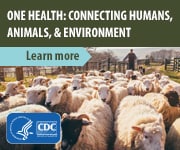Horses
See the Farm Animals page for information about other animals commonly found on farms.
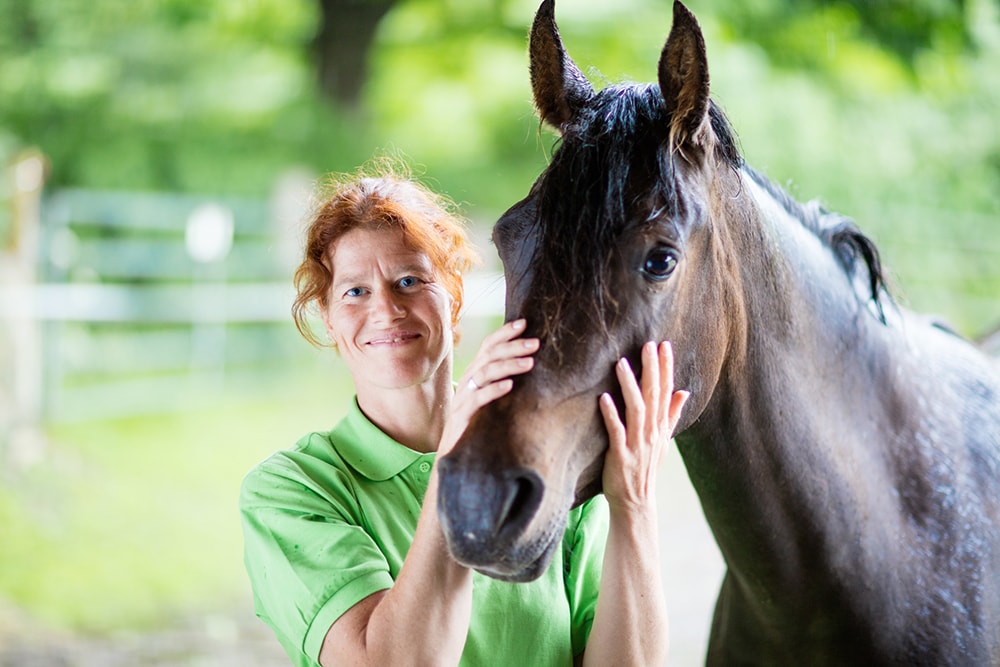
From pulling a plow over a farmer’s field to carrying a cowboy across the open range, horses have always had an important role in society. Today, horses are generally considered companion animals, with close to 2 million U.S. households reporting horse ownership.
Riding and working around horses have been shown to increase balance, self-confidence, and self-esteem. However, as with any animal, people who work with or own horses should be aware that sometimes horses can carry harmful germs that can cause a variety of illnesses in people, ranging from minor skin infections to serious illnesses. Besides touching a horse, common chores such as cleaning stalls and grooming might put you at risk. One of the best ways you can protect yourself from getting sick is to thoroughly wash your hands after handling, cleaning up after, or feeding horses.
By providing your horse with routine veterinary care and following the Healthy People tips, you are less likely to get sick from touching or owning a horse.
Read below to learn about diseases that can be spread by horses and visit the Healthy People section to learn about staying healthy around horses.
Anthrax is a naturally occurring disease of animals caused by bacteria found in the environment. Although it is rare in the United States, people can get sick with anthrax if they come in contact with infected animals, including horses. People who live in areas where anthrax has occurred should consider vaccinating their livestock against the disease every year.
How it spreads: Horses can become infected with anthrax when they ingest spores in contaminated soil, plants, or water. People get infected by having contact with sick, dead animals or eating meat contaminated with spores. People can also get anthrax through a cut or scrape in the skin. Anthrax is not contagious, which means it can’t be spread from person to person.
Who is at risk: Anthrax is rare in the United States, but anyone who comes in contact with anthrax spores can get sick. People at higher risk for anthrax include veterinarians, livestock producers, laboratory professionals, and people who handle animal products.
Signs in horses: Signs of anthrax in horses may include fever, chills, severe colic, anorexia, depression, weakness, bloody diarrhea, and swellings. Anthrax is usually fatal in horses.
Symptoms in people: The symptoms of anthrax in people depend on the type of infection and can take anywhere from 1 day to more than 2 months to appear.
- Cutaneous (skin) anthrax: A group of small blisters or bumps, a painless skin sore (ulcer) with a black center (scar) appearing after the small blisters, and swelling.
- Inhalation anthrax (from breathing in spores): Fever and chills, shortness of breath and chest discomfort, confusion, nausea or vomiting, headache, sweats, extreme tiredness, and body aches. This type of anthrax is very rare and mostly associated with an intentional spore release (bioterrorism).
- Ingestion (stomach & intestines) anthrax: Fever and chills, swelling of neck or neck glands, sore throat, painful swallowing, diarrhea or bloody diarrhea, red face and eyes, and stomach pain.
All types of anthrax have the potential, if untreated, to spread throughout the body and cause severe illness and even death.
Brucellosis is a bacterial disease caused by contact with infected animals and contaminated animal products like raw milk. In horses, brucellosis can cause lameness due to joint infection, including fistulous withers and “poll evil.” It can also cause abortions in pregnant mares, although this is less common.
How it spreads: The most common way people get brucellosis is by eating or drinking unpasteurized/raw dairy products. People can also get brucellosis by coming in contact with infected animals or contaminated animal tissues or fluids (such as blood) and getting the bacteria in skin wounds or mucus membranes.
Who is at risk: Anyone can get brucellosis, but people who drink raw milk or work closely with animals may be more at risk. It is rare for people to get brucellosis from horses.
Signs in horses: In horses, brucellosis causes fistulous withers, or “poll evil,” which is when there is inflammation and swelling in the bursa (the sac of fluid between bone and soft tissue) of ligaments. This inflammation and swelling typically affects the withers (highest part of the horse’s back) or poll (the part of the horse’s head behind the ears). The inflamed tissue might eventually burst, resulting in drainage of pus and further infection of the surrounding tissue. Brucellosis can also affect an animal’s ability to reproduce, though it rarely causes abortions in horses.
Symptoms in people: People with brucellosis will usually become sick within 2-4 weeks of exposure, but symptom onset can begin anywhere between 5 days to 6 months after exposure. Sick people will have flu-like symptoms. Sometimes brucellosis can become a chronic illness that can be difficult to treat and potentially lead to more severe health consequences. Occasionally, brucellosis can affect reproductive organs and cause miscarriage.
Cryptosporidiosis is a parasitic disease caused by the germ Cryptosporidium (or Crypto for short), which is spread by swallowing poop from an infected person or animal.
How it spreads: Crypto spreads through swallowing poop containing the germ, after contact with an infected person or animal or through food or water contaminated with poop. The risk of getting Crypto from animals is hard to predict, because many animals can be infected with the parasite but not have any signs of being sick.
Who is at risk: Anyone can been infected with Crypto, people with weakened immune systems and young children are more at risk of serious illness. For tips on how to protect yourself and loved ones, visit CDC’s Crypto Prevention & Control webpage.
Signs in horses: Horses infected with Crypto might or might not have any signs of being sick. If infected with Crypto, pre-weaned foals appear to be more likely to experience diarrhea than weanlings and yearlings, and older horses.
Symptoms in people: People infected with Crypto might or might not have signs of being sick. Patients with healthy immune systems can experience frequent, non-bloody, watery diarrhea (typically lasting 1–2 weeks) with nausea, vomiting, abdominal pain, and fever. Patients with weakened immune systems can experience profuse watery diarrhea lasting weeks to months or even life-threatening malnutrition and wasting.
Dermatophilosis is a skin disease caused by bacteria that can affect people and animals. Dermatophilosis mainly affects deer, but also can affect cattle, sheep, horses, and goats. This infection is more common in moist or humid environments.
How it spreads: The bacteria spread through contact with an infected animal, contact with contaminated surfaces, and bites from fleas and ticks. The bacteria can spread to people through direct contact with an infected animal.
Who is at risk: People who handle animals, especially deer, are at higher risk for getting dermatophilosis. People with weakened immune systems are more likely to get severe illness.
Signs in wildlife: Infected animals might have matted hair, scabs, crusts, and areas of hair loss. Although some animals with severe infections may become emaciated and die, most infections are mild and will heal with time.
Symptoms in people: Infected people might have sores on the hands and arms.
In the United States, mosquitoes spread several viruses that can cause encephalitis in horses, including eastern equine encephalitis (EEE), West Nile, and western equine encephalitis (WEE). Horses can be vaccinated for EEE, West Nile virus, and WEE. Venezuelan equine encephalomyelitis (VEE) can also affect horses, but it is incredibly rare in the United States.
How it spreads: Mosquitoes spread these viruses through infective bites. Animals, including birds and horses, can get infected through mosquito bites. Mosquitoes get infected after biting an infected bird or animal. Mosquito prevention and reducing the number of mosquitoes on your property can help prevent the spread.
Who is at risk: People and horses with weakened immune systems are at greater risk of illness. People at high risk include infants, older adults, and people with certain medical conditions. People who spend time outside are at greater risk of being bitten.
Signs in horses: Horses infected with one of these viruses may or may not show signs of disease. Signs and symptoms range from mild illness to death. Horses with nervous system disease can have depression, trouble walking, paralysis, convulsions, or other neurologic signs. These diseases are potentially life-threatening, so it’s important to contact your veterinarian immediately if you are concerned that your horse could be sick with one of these viruses.
Symptoms in people: Most people with EEE or SLE have no symptoms, but for those who become sick, symptoms can range from mild flu-like symptoms to complex neurologic problems and death. Neurologic signs can include arthritis, respiratory distress, gastrointestinal (stomach) upset, myelitis (spinal cord inflammation), encephalitis (brain inflammation), retinitis, severe muscular weakness, Guillain-Barré syndrome, and partial paralysis, shock, or death.
Leptospirosis is a bacterial disease that can affect people and animals. Many kinds of animals can carry the bacteria in their urine, including horses.
How it spreads: The bacteria that cause leptospirosis spread through the urine of infected animals, which can get into water or soil and survive there for weeks to months. People get infected through contact with urine or other body fluids (except saliva) from infected animals, or through contact with water, soil, or other materials (such as animal bedding) contaminated with urine from infected animals.
Who is at risk: Leptospirosis occurs worldwide, but is most common in tropical and subtropical climates. It has been associated with contact with infected animals and activities in contaminated lakes and rivers, such as swimming, wading, kayaking, and rafting. It is also a risk for people in certain jobs that involve contact with animals or their waste, like farmers, sewer workers, slaughterhouse workers, and veterinarians. People working directly with horses or cleaning up after them (such as mucking stalls) may be at risk for leptospirosis.
Signs in horses: In horses, leptospirosis is most often associated with eye problems, such as cloudiness or the eye or uveitis (inflammation in the eye). It can also cause other symptoms such as fever, stillbirths and abortions, and kidney failure.
Symptoms in people: People with leptospirosis might not have any symptoms, but those who do will usually become sick within 2 days to 4 weeks of exposure and can have high fever, headache, chills, muscle aches, vomiting, jaundice, red eyes, abdominal pain, diarrhea, and rash. A small number of people with leptospirosis can have more severe disease, such as liver and kidney failure, hemorrhagic pneumonia, and even death. Early treatment with antibiotics is important, and can reduce the duration and severity of illness.
Staphylococcus aureus is a common type of a bacteria normally found on the skin of people and animals. MRSA is Staphylococcus aureus bacteria that have become resistant to some antibiotics. MRSA can cause a variety of infections, including skin infections, pneumonia (lung infection), and other problems.
How it spreads: MRSA can spread between people and animals through direct contact (touching). Even horses that aren’t sick can carry MRSA and spread it to people.
Who is at risk: Anyone can get a MRSA infection.
Signs in horses: Horses carrying MRSA might not necessarily show signs, but MRSA can cause skin and wound infections, respiratory tract infections, and septic arthritis. Horses are more likely to carry MRSA if they live on a farm with more than 20 horses.
Symptoms in people: Most people with MRSA will carry it without symptoms. For people who develop a MRSA infection, the most common type is a skin infection. If left untreated, MRSA can rarely spread to the lungs or bloodstream and become life-threatening.
Rabies is a deadly neurologic disease caused by a virus that spreads primarily through bites of infected animals. Though rabies is very rare in horses, it is still a concern. Horse owners should vaccinate their animals against rabies.
How it spreads: Rabies is spread through contact with saliva or brain/nervous system tissue from an infected animal, usually through scratches or bites.
Who is at risk: Rabies in people and domestic animals is rare in the United States because of successful animal control and vaccination programs, but the disease is still found in wild animals such as bats, foxes, raccoons, and skunks. You or your horse could be at risk for rabies if you come into contact with an infected animal.
Signs in horses: Rabies in horses is very rare. Horses with rabies might have a variety of signs that rapidly worsen. Most frequently, rabid horses will have abrupt changes in their behavior (depression, agitation, aggressiveness) and may develop paralysis. Rabid horses can be very dangerous and have attacked people.
Symptoms in people: Symptoms of rabies in people can appear days to months after exposure. Once symptoms appear, it is almost always too late for treatment, so if you have been bitten by an animal, you should wash the wound immediately and see a doctor right away.
Ringworm is an infection caused by fungus that can infect the skin, hair, or nails of people and animals.
How it spreads: Ringworm spreads through direct contact with (touching) an infected animal or person, or from the environment.
Who is at risk: Anyone can get ringworm.
Signs in horses: Some horses might not show signs of ringworm infection, but others can have circular areas of hair loss anywhere on their bodies, redness, dry skin, depression, and severe dehydration.
Symptoms in people: Ringworm can affect skin on almost any part of the body as well as fingernails and toenails. The symptoms of ringworm often depend on which part of the body is infected, but they generally include itchy skin, ring-shaped rash, red, scaly, cracked skin, and hair loss.
Salmonellosis is a disease caused by Salmonella bacteria, which are most commonly spread through contaminated food. Salmonella can also spread from animals, including horses, to people and between people.
How it spreads: Salmonella most often spread to animals and people through the feces (poop) of infected animals, contaminated food, or the environment. People can become infected if they don’t wash their hands after touching a horse or its poop, food, toys, or habitat.
Who is at risk: Anyone can get a Salmonella infection, but children younger than 5 years old, adults 65 and older, and people with weakened immune systems are more at risk for serious illness. People who are in contact with horses should be aware that they are at an increased risk for Salmonella infection.
Signs in horses: Horses infected with Salmonella might show no signs of illness, or they may experience diarrhea, dehydration, or depression. One of the most common causes of diarrhea in adult horses is from infection with Salmonella, so if your horse appears sick, call your veterinarian. The diarrhea and dehydration can be severe and even life threatening.
Symptoms in people: People with a Salmonella infection may experience diarrhea, fever, and abdominal cramps. Symptoms usually start 6 hours–4 days after infection and last 4–7 days.
Horses are at risk for tickborne infections, including Lyme disease, tularemia, and anaplasmosis. Horse owners should talk to a veterinarian about preventing ticks on horses. Treating horses for ticks can reduce the risk of tickborne diseases for you and your horse.
How it spreads: Ticks get infected after biting an infected animal. Tickborne germs are spread through the bite of an infected tick.
Who is at risk: People and horses that spend time in grassy, wooded, or brushy areas are at risk for tick bites. Horses may have ticks in and around the ears, around the eyelids, under front legs, between back legs, or around the tail. Remove ticks from horses promptly or treat your horse for ticks to reduce disease risk.
Signs in horses: Horses infected with a tickborne disease may or may not show signs of disease. Signs and symptoms range from mild illness to death.
For example, anaplasmosis is caused by the bacteria Anaplasma phagocytophilum. In horses, signs and symptoms can include fever; depression; lack of appetite; swelling of limbs, the underside of the chest, or abdomen; and discoloration of mucous membranes.
Symptoms in people: Symptoms of tickborne diseases in people can vary, but usually include fever, chills, body aches, and sometimes a rash. Some tickborne diseases can be very serious and even deadly. See your healthcare provider if you have been in tick habitat or been bitten by a tick and develop any of these symptoms.
Vesicular stomatitis is a viral disease that mainly infects horses and cattle, but also can infect deer, bobcats, raccoons, feral pigs, and rodents. Rarely, people can get vesicular stomatitis.
How it spreads: In animals, this virus spreads through direct contact and insect bites. The virus can spread to people through contact with infected animals (or their tissues or blood) or surfaces contaminated with saliva from infected animals.
Who is at risk: Vesicular stomatitis is rare in people, but those who handle animals are more likely to be exposed.
Signs in wildlife: Infected animals might have fluid-filled blisters around the mouth, on their feet, or under the belly. Vesicular stomatitis can also cause fever, drooling, and loss of appetite.
Symptoms in people: Infected people might have flu-like illness with fever, muscle aches, and fatigue. Some infected people also might have blisters in their mouth or on their hands. Other people might not have any symptoms.
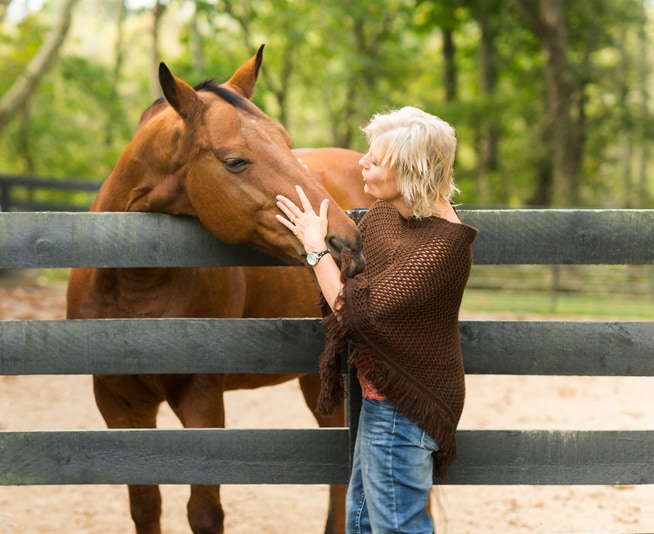
How to stay healthy around horses
Before you interact with horses, be aware that horses can sometimes carry germs that can make people sick, even when they appear healthy and clean. Always get routine veterinary care for your horse to keep it healthy and to prevent infectious diseases.
Wash your hands
- Wash your hands thoroughly with soap and running water:
- After contact with horses or their equipment
- After doing chores such as cleaning stalls, brushing your horse, or cleaning equipment
- After riding your horse or touching horse poop, urine, saliva, or blood
- Before you eat or drink
- Adults should supervise hand washing for children under 5 years of age.
Use hand sanitizer if soap and water are not readily available. Be sure to have hand sanitizer readily available near the horse’s stall to encourage others to use it before handling the horse or its equipment.
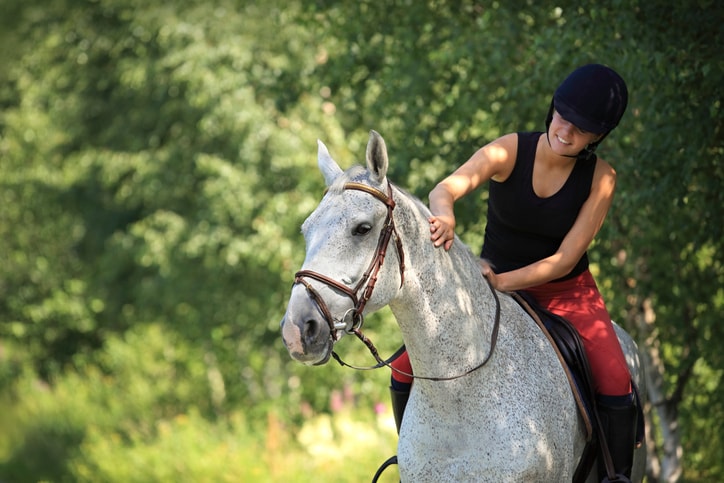
Prevent horse bites and kicks
Kicks and bites from horses can cause serious injury and sometimes illness. Bites and kicks can spread germs, even if the wound does not seem deep or serious.
- Be aware of your surroundings and know where the horse is at all times.
- Be cautious when approaching a horse.
- Approach a horse’s head from the side where they can see you better—not from the front.
- Watch their ears—if the ears are flattened, the horse might bite.
- Don’t stand directly behind a horse.
- Don’t approach a horse from its rear end.
- Don’t leave young children unsupervised around horses.
What to do if you are bitten or injured by a horse
If you are injured by a horse, you should:
- Wash wounds with warm, soapy water immediately.
- Seek medical attention if:
- You don’t know the vaccination status of the horse.
-
- The horse might have been exposed to a rabid animal. Make sure a veterinarian checks the horse if it becomes sick or dies within 6 months of a bite from another animal.
- The horse appears sick or is acting unusual.
- The wound or injury is serious (uncontrolled bleeding, unable to move, extreme pain, muscle or bone is showing, or the bite is over a joint).
- The wound or site of injury becomes red, painful, warm, or swollen (especially if the person bitten is 5 years of age or younger, 65 years of age or older, pregnant, or has a weakened immune system.)
- Your or your child’s last tetanus shot was more than 5 years ago.
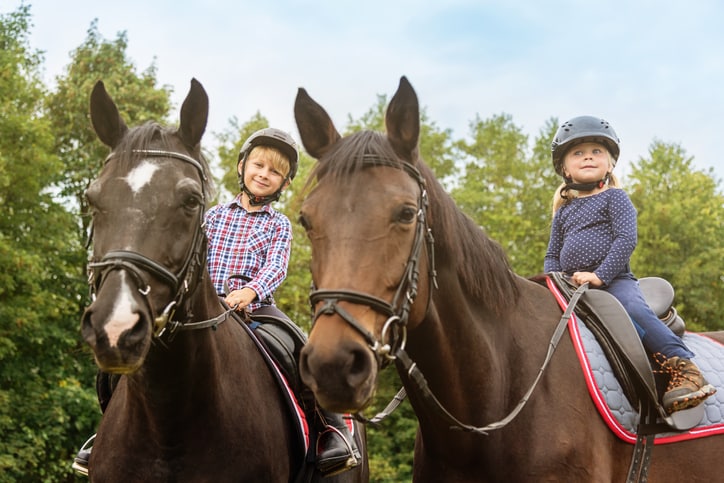
How to keep horses healthy
Keeping your horse healthy helps to keep you and your family healthy. To learn how to stay healthy around horses, visit the Healthy People section.
Before choosing a horse
- Learn about the different types of horses and temperaments before you bring one home.
- Find out what types of horses are suitable for your family. Some horses, such as young or untrained horses, might not be suitable for young children or people with very little riding experience.
- Research how to properly care for your horse. Ask a veterinarian about the proper food, care, and stall or pasture environment for the horse you are selecting.
- Be aware of the potential for your horse to spread germs to people and other animals.
How to choose a horse
- Match the horse’s attitude, temperament, size, and training or activity level with:
- Your family’s time and ability to train and care for them
- The purpose for which you are buying the horse (for example, showing, trail riding, teaching)
- Consider having the horse thoroughly examined by a veterinarian before purchase to make sure the animal is healthy and is not carrying diseases that could pass to people.
- If you are bringing the horse into a herd setting, you might need to keep the horse separate for a short time to prevent any diseases from spreading to your other horses.
- Some general guidelines for choosing to separate a newly purchased horse are if:
- It has an unknown medical history
- It is coming from an unknown source, sale barn, or horse show where it has been in contact with unknown horses
- It traveled a long distance and is stressed or showing signs of disease, such as a cough, runny nose, swollen lymph nodes, fever or diarrhea
- For more information on separating newly acquired horses, contact a veterinarian.
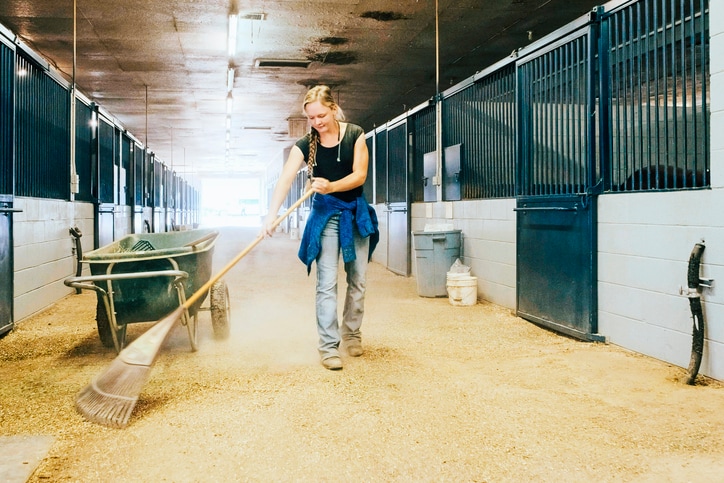
How to house your horse
- House horses in a stall, out on pasture, or in a combination of both. If they are out on pasture, they should have some kind of shelter in case of bad weather.
- Make sure your horse always has access to clean water, whether in a stall or out in a pasture.
- Clean horse stalls daily to prevent build-up of feces (poop) that could spread disease to your horse or to you and your family.
- Dispose of poop, soiled bedding, and uneaten food properly.
Monitor your horse’s health
- Have your veterinarian visit your horse’s stall often to care for and check your horse’s health.
- Talk to your veterinarian about vaccinations for rabies, West Nile, and other viruses causing equine encephalitis.
- If possible, keep horses in an enclosed area at night to decrease their exposure to wild animals that could be carrying rabies and other diseases.
- Use feeders that are above the ground to keep wild animals away from your horse and your horse’s food.
Selecting and caring for a horse
- Selecting a Horse [PDF – 2 pages]
American Veterinary Medical Association - Bringing Horses into the United States
- Get-A-DVM
American Association of Equine Practitioners - Farm Animal Emergency Preparedness (Blog)
Staying healthy around horses
Diseases associated with horses
- Salmonellosis
- Ringworm
- Anthrax
- Brucellosis
- Cryptosporidiosis
- Eastern Equine Encephalitis (EEE)
- St. Louis Encephalitis (SLE)
- Tickborne diseases
- Leptospirosis
- MRSA
- Rabies
